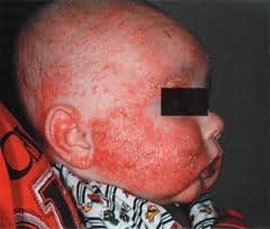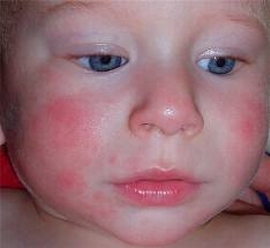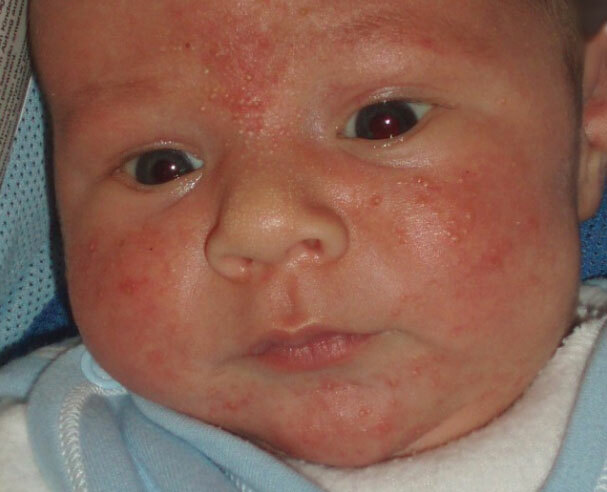The reasons for the spread of allergization of the population are still undefined and cause much controversy and discussion. According to the most common theory, the development of allergies is associated with a decrease in antigen load in people living far from nature in civilized countries.
In urban conditions, there are not as many allergens as there are, for example, in the forest. Basically it is the pollen of various plants, the secrets of a multitude of insects, the wool of animals and so on. In the city, on the contrary, various "simple" chemicals, gases, toxins, etc. predominate.
Thus, a person who grew up in urban conditions, did not prepare his immune system for such a huge antigenic load in real natural conditions. Therefore, an allergy refers to diseases associated with the development of civilization.
Allergy to the skin in children
Allergy can manifest itself differently from a simple cold, to anaphylactic shock with a fatal outcome. In this article, we will talk about skin manifestations of allergies.
Allergy to the skin in children - photo

Epidemiology and prevalence of
According to a number of authors, mostly foreign countries, allergies with cutaneous manifestations( allergic dermatoses) occur in 20% of allergic patients. In children, this figure is 60%. That is, every second child, suffering from allergies, has some kind of skin manifestations.
Idiosyncrasy
Allergies should be distinguished idiosyncrasy, which is a perverse reaction of the body to a chemical substance. Idiosyncrasy is a problem of metabolism, and not a consequence of the hyperreactivity of the immune system.
Allergic diseases with cutaneous manifestations:
- atopic dermatitis;
- allergic dermatitis( contact);
- urticaria;
- Quincke edema;
- Lyell syndrome.
How is skin allergy manifested in children( general symptoms):
- redness of the skin( general or local);
- inflammatory changes in the skin
- blistering as in scalding nettle;
- skin itch of varying intensity, pain, burning;
- appearance of calculi on the body( excoriation);
- poor sleep and, as a result, a decrease in well-being, mood and performance.
Consider the above skin allergic diseases in more detail.
Atopic dermatitis
 Atopy means a predisposition of the child's organism to this or that allergic disease. Atopy is caused by genetic factors. If the father or mother of the child suffered any allergic disease, the risk of developing an allergic disease in the child is dramatically increased.
Atopy means a predisposition of the child's organism to this or that allergic disease. Atopy is caused by genetic factors. If the father or mother of the child suffered any allergic disease, the risk of developing an allergic disease in the child is dramatically increased.
Atopic dermatitis is a disease that is manifested by inflammation of the skin due to excessive activation( hypersensitivity) of the immune system to this or that allergen. In this disease, foci of inflammation of the skin can appear on different parts of the body. The inflammation itself belongs to the category of aseptic, since it is not associated with bacteria or viruses, but with a violation of microcirculation in the zone of the inflammatory elements of the skin.
Microcirculation is disrupted by the effect of a large number of antigens produced on the allergen on the wall of the capillary located in the skin. The capillary itself is damaged and triggers an inflammatory reaction that leads to a disruption of the blood supply of tissues in the area of this capillary.
Inflammatory foci on the skin are manifested by reddening, flaking, itching, swelling. As a rule, they have distinct edges. Around them there may be scrapes due to itching. When joining a secondary infection, they may develop pus( secondary pyoderma).
Atopic dermatitis can be combined with other allergic diseases, such as bronchial asthma, urticaria, allergic rhinitis and conjunctivitis( polynosis).
The most severe and dangerous form of atopic dermatitis is erythroderma, in which the entire skin is affected. In addition to the skin manifestations described above, the patient has symptoms of intoxication in the form of fever, swollen lymph nodes, deterioration of health, headache, body aches, and the like.
Allergic contact dermatitis
 This pathology is caused by contact of the skin with substances to which the immune system reacts by its activation. A distinctive feature of this disease is that signs of aseptic inflammation occur in the place of skin contact with the allergen. As an allergen can act, for example, bed linen processed by any chemical substance, woolen jacket, various chemicals that get on the skin for one reason or another. In the place of skin contact with the allergen there is redness and puffiness of the skin, bubbles of various sizes, which are filled with transudate( liquid). After these bubbles burst, damp erosions form in their place, which are an excellent place to attach a secondary infection. The very infiltration( puffiness) of the skin is due to the fact that special inflammatory cells enter the inflammation site - lymphocytes, ready to repel foreign agents.
This pathology is caused by contact of the skin with substances to which the immune system reacts by its activation. A distinctive feature of this disease is that signs of aseptic inflammation occur in the place of skin contact with the allergen. As an allergen can act, for example, bed linen processed by any chemical substance, woolen jacket, various chemicals that get on the skin for one reason or another. In the place of skin contact with the allergen there is redness and puffiness of the skin, bubbles of various sizes, which are filled with transudate( liquid). After these bubbles burst, damp erosions form in their place, which are an excellent place to attach a secondary infection. The very infiltration( puffiness) of the skin is due to the fact that special inflammatory cells enter the inflammation site - lymphocytes, ready to repel foreign agents.
Contact dermatitis should not be confused with photodermatitis, which many people met, if not all. It occurs when a person is in the sun for a long time and shows reddening and soreness of the skin until the appearance of bubbles. This is a simple solar( radiation) burn.
However, some people have increased sensitivity to the sun. In such people even a few minutes under the sun can lead to severe burns of the skin. Also, some medicines( photosensitization) may cause increased sensitivity to ultraviolet radiation.
Urticaria
 Urticaria is an allergic disease, the skin manifestations of which are the formation of highly itchy papules with reddening of the skin around them. Papula( blister) is a malignant formation that occurs as a result of edema of the papillary dermis. Papules can measure from 0.5 cm to 15 cm. With this edema, the pain receptors( nerve endings) are squeezed, which causes the itching sensation. The same papules occur when scalding nettle, which is why the name of this disease occurred.
Urticaria is an allergic disease, the skin manifestations of which are the formation of highly itchy papules with reddening of the skin around them. Papula( blister) is a malignant formation that occurs as a result of edema of the papillary dermis. Papules can measure from 0.5 cm to 15 cm. With this edema, the pain receptors( nerve endings) are squeezed, which causes the itching sensation. The same papules occur when scalding nettle, which is why the name of this disease occurred.
Skin manifestations of hives can occur acutely or gradually. But somehow, after a while they pass without a trace.
Urticaria can occur not only on certain allergens. Its development can also provoke various physical factors( increased physical activity, cold, various mechanical effects on the skin and others).
The extreme degree of urticaria( giant urticaria) is called Quincke's edema.
Quincke edema
Quincke edema is a local edema of the skin, mucous and subcutaneous fat due to excessive activation of the immune system. It is associated with a sharp increase in vascular permeability due to the release( degranulation) of mast cells by a special substance - histamine. This edema most often occurs on the facial area and in the external genital area. The skin swells, becomes denser and pale( sometimes pink).
Very dangerous situation with edema of the larynx. It is possible to develop asphyxia( stop breathing).This situation requires urgent medical intervention.
Laella Syndrome
 This pathology occurs in response to the introduction of various medicines into the child's body. It is manifested by the fact that the child's condition worsens dramatically, symptoms of intoxication appear, and the temperature rises. Then there is a skin rash, similar to the root. A few hours later, huge flat bubbles appear on the site of the rash and unaffected skin, which are filled with clear liquid and sometimes with blood. The child is literally covered in a lot of skin. If you draw a finger along it, it will burst( Nikolsky's symptom).These bubbles are opened, burst and erosion forms in their place. In addition, symptoms of intoxication can lead to lesions of some internal organs. Therefore, if such a child is not provided with qualified medical care in a medical institution, then everything can end in a lethal outcome.
This pathology occurs in response to the introduction of various medicines into the child's body. It is manifested by the fact that the child's condition worsens dramatically, symptoms of intoxication appear, and the temperature rises. Then there is a skin rash, similar to the root. A few hours later, huge flat bubbles appear on the site of the rash and unaffected skin, which are filled with clear liquid and sometimes with blood. The child is literally covered in a lot of skin. If you draw a finger along it, it will burst( Nikolsky's symptom).These bubbles are opened, burst and erosion forms in their place. In addition, symptoms of intoxication can lead to lesions of some internal organs. Therefore, if such a child is not provided with qualified medical care in a medical institution, then everything can end in a lethal outcome.
Symptoms of skin allergy in children
How to identify an allergy in a child?
For this, first of all, they collect a qualitative anamnesis. The doctor who collects an anamnesis should find out under what conditions allergic reactions appear. This allows you to determine the list of suspected allergens.
Determination of immunoglobulin E( IgE). This immunoglobulin is an antibody to a specific allergen and its increase in blood means that the immune system is overly activated with respect to this antigen.
 Allergic tests can identify the necessary antigen, among the suspects. They are performed as follows. On the clean skin of the forearm, solutions with suspected allergens are applied in several places( no more than 15 at a time).Then in these places the applications make small scratches by one-time scarifiers.
Allergic tests can identify the necessary antigen, among the suspects. They are performed as follows. On the clean skin of the forearm, solutions with suspected allergens are applied in several places( no more than 15 at a time).Then in these places the applications make small scratches by one-time scarifiers.
With a positive reaction to the allergen in the place of scratches, itching and swelling of the skin appears, the magnitude of which is judged about the reaction of the immune system.
This examination should only be carried out in a medical facility in which there is a special setting against anaphylactic shock.
Treatment of skin allergies in children
Treatment of allergic reactions in children is treated by a pediatrician or an allergist.
First of all, it is necessary to exclude the allergen from the environment of the child. If an allergy occurs on food, then it is necessary to transfer the child to a special hypoallergenic diet, from which fish and other seafood, eggs, citrus fruits and other fruits with high content of ascorbic acid( vitamin C) are excluded.
In the development of allergic reactions the main role belongs to histamine. Therefore, the use of antihistamines is the main pathogenetic treatment.
Now there are many drugs with antihistaminic activity. Among them, blockers of histamine( H2) receptors and stabilizers of mast cell membranes can be isolated. These medicines are divided into generations. Preparations of the first generation penetrate the hemoencephalic barrier and cause drowsiness. Sometimes this is useful, for example, to stimulate a child's sleep. The first generation of these medicines includes diphenhydramine. But that the child was not constantly sleepy, it is better to use second and third generation drugs, such as claritin, suprastin, cetrine and others. They have fewer side effects and are taken only once a day. The course of treatment with these drugs is chosen by the attending physician and, as a rule, it corresponds to the time of maximum exposure of the allergen to the child's organism( spring, the time of flowering of various plants).
Allergen-specific immunotherapy. One of the methods to combat allergy is the gradual training of the organism to allergens. To do this, allergen is injected with insulin syringes with solutions of therapeutic allergens of deliberately low concentration and this concentration gradually increases with time. This treatment is carried out under the close supervision of an allergist and is carried out for a long time. But this treatment is highly effective. It does not cure of allergies at all, but it can allow a sick person to forget about it for several years and reduce the amount of expensive antiallergic drugs taken.
In addition to pathogenetic treatment, as well as symptomatic and topical treatment is used.
Prevention of allergy
Great importance for the prevention of allergic reactions should be given to the nutrition of both the child and the mother. It is necessary to strive for breastfeeding of the child. In the future, if necessary, the pediatrician will advise you necessary hypoallergenic diets. If there is an allergy to the pollen of plants, it is necessary during flowering, they are not in nature and stay at home more. At home you need to use synthetic materials. The same principle must be adhered to when choosing clothes. When allergic to dust, the apartment needs to be ventilated and perform daily wet cleaning.
Video: Allergic skin manifestations
 Allergy is one of the main medical problems of the XXI century.
Allergy is one of the main medical problems of the XXI century.



